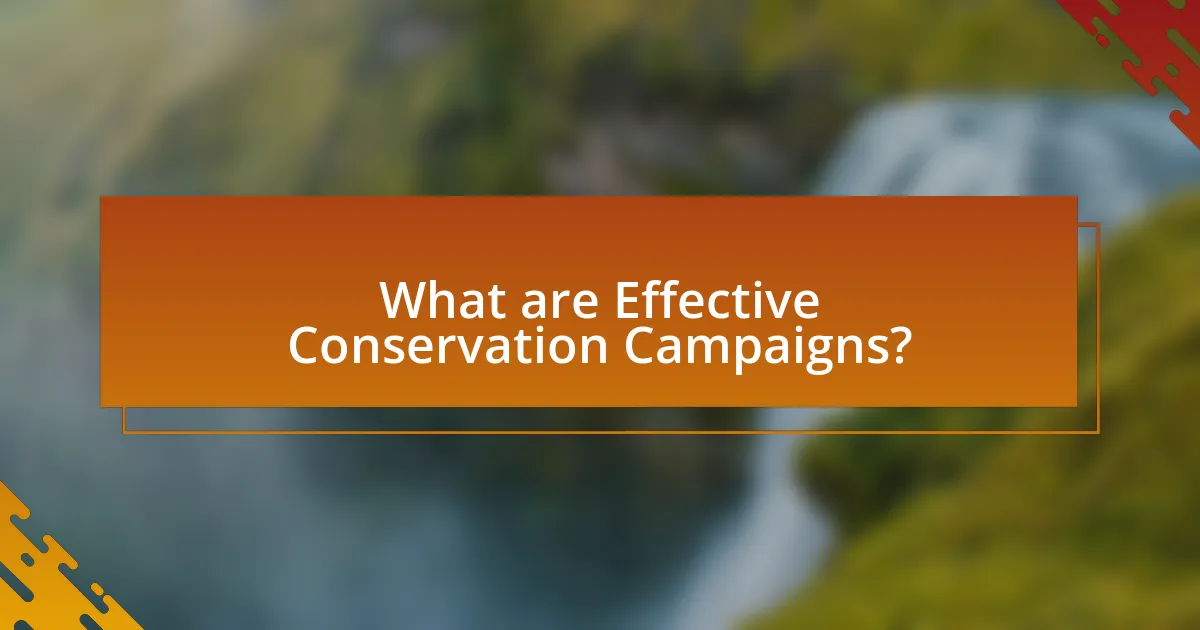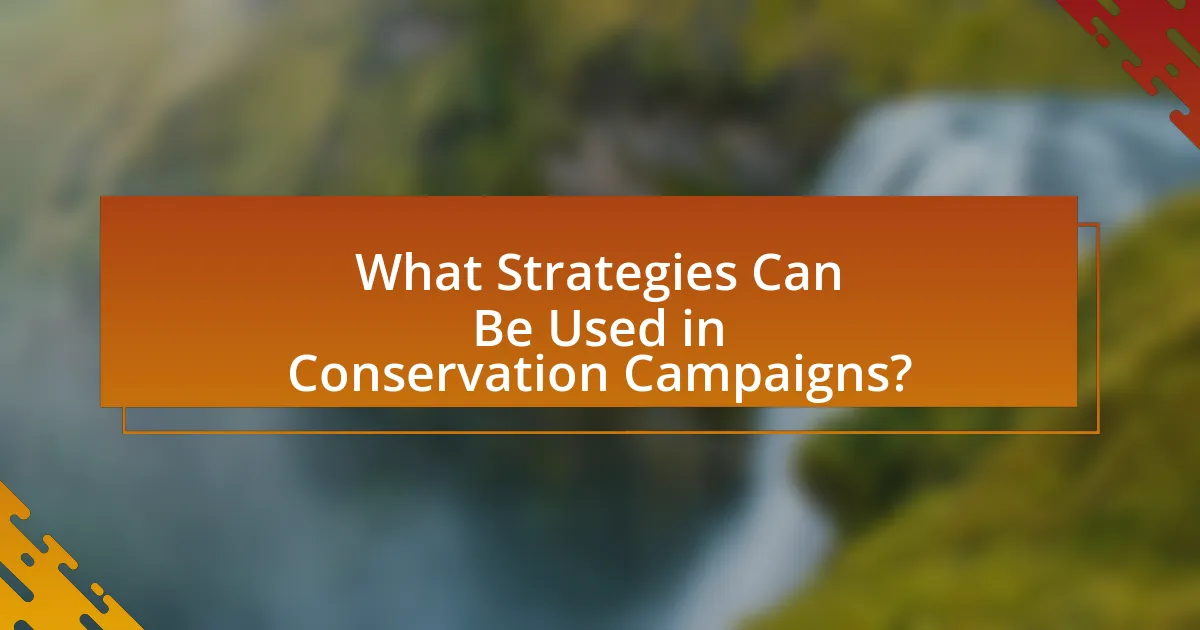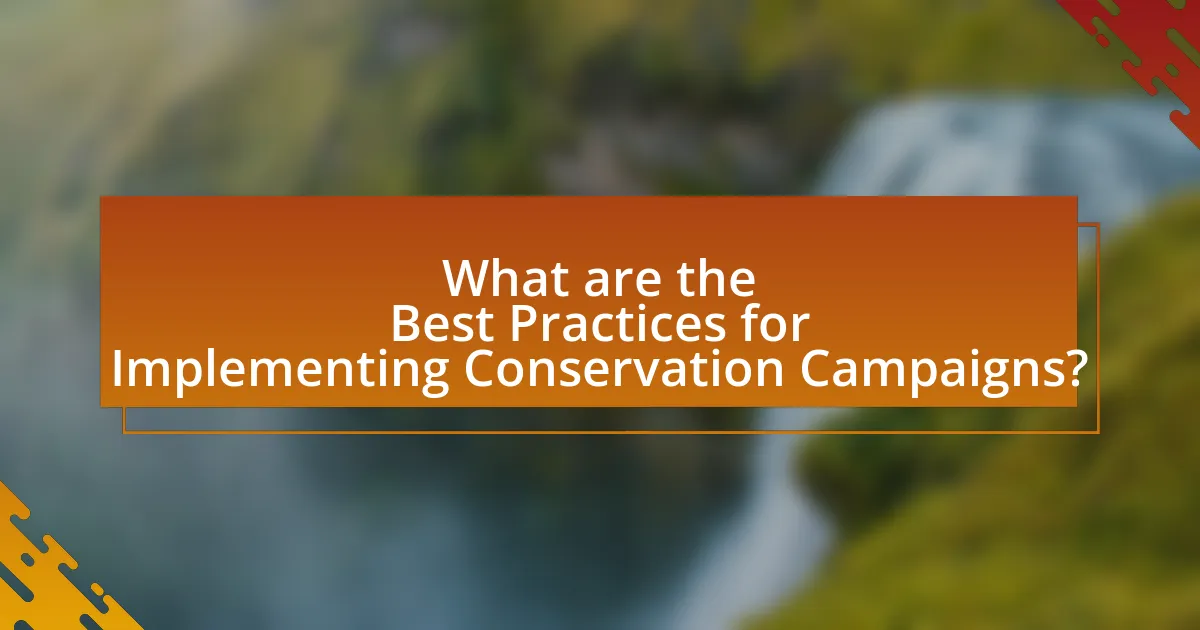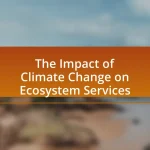Creating effective conservation campaigns involves strategic initiatives aimed at raising awareness, influencing behavior, and driving action for the protection of natural resources and biodiversity. The article outlines the key elements of successful campaigns, including clear objectives, targeted messaging, community engagement, and measurable outcomes. It discusses the impact of conservation campaigns on environmental awareness and public behavior, highlighting the importance of emotional storytelling and social media in enhancing engagement. Additionally, the article addresses best practices for implementation, challenges faced, and strategies to overcome funding limitations and misinformation, providing a comprehensive guide for organizations seeking to maximize their conservation efforts.

What are Effective Conservation Campaigns?
Effective conservation campaigns are strategic initiatives designed to raise awareness, influence behavior, and drive action towards the protection of natural resources and biodiversity. These campaigns utilize targeted messaging, community engagement, and evidence-based practices to achieve measurable outcomes, such as increased public support for conservation policies or enhanced participation in sustainable practices. For instance, the “Save the Whales” campaign successfully mobilized public opinion and led to significant legislative changes in marine conservation, demonstrating the effectiveness of well-structured campaigns in achieving conservation goals.
How do conservation campaigns impact environmental awareness?
Conservation campaigns significantly enhance environmental awareness by educating the public about ecological issues and promoting sustainable practices. These campaigns utilize various communication strategies, such as social media, community events, and educational programs, to reach diverse audiences. For instance, a study published in the journal “Environmental Communication” found that targeted messaging in conservation campaigns can increase knowledge and change attitudes towards environmental issues, leading to higher engagement in conservation activities. Additionally, campaigns like Earth Hour have demonstrated measurable increases in public participation in energy-saving initiatives, showcasing the direct impact of awareness on behavior change.
What are the key elements of a successful conservation campaign?
The key elements of a successful conservation campaign include clear objectives, targeted messaging, community engagement, strategic partnerships, and measurable outcomes. Clear objectives define the specific goals of the campaign, such as protecting a species or habitat. Targeted messaging ensures that the communication resonates with the intended audience, utilizing data to highlight the urgency of the conservation issue. Community engagement fosters local support and participation, which is crucial for grassroots movements. Strategic partnerships with organizations, businesses, and influencers amplify the campaign’s reach and resources. Finally, measurable outcomes allow for the assessment of the campaign’s effectiveness, using metrics such as increased awareness or habitat restoration success rates to demonstrate impact.
How do conservation campaigns influence public behavior?
Conservation campaigns influence public behavior by raising awareness and promoting sustainable practices. These campaigns utilize various strategies, such as emotional storytelling and community engagement, to connect with individuals and motivate them to adopt environmentally friendly behaviors. For instance, a study published in the journal “Environmental Communication” found that campaigns using personal narratives significantly increased participants’ intentions to engage in conservation activities, demonstrating the effectiveness of emotional appeal in driving behavioral change. Additionally, campaigns that involve local communities often lead to higher participation rates, as seen in initiatives like community clean-up events, which foster a sense of ownership and responsibility towards local environments.
Why is it important to create effective conservation campaigns?
Creating effective conservation campaigns is crucial because they raise awareness and drive action towards protecting biodiversity and natural resources. These campaigns mobilize communities, influence policy changes, and secure funding for conservation efforts. For instance, the World Wildlife Fund’s “Earth Hour” campaign has successfully engaged millions globally, leading to significant reductions in energy consumption and increased support for environmental policies. Effective campaigns utilize targeted messaging and strategic partnerships to maximize their impact, demonstrating that well-executed conservation initiatives can lead to measurable environmental benefits.
What role do conservation campaigns play in biodiversity protection?
Conservation campaigns play a crucial role in biodiversity protection by raising awareness, mobilizing resources, and influencing policy changes. These campaigns educate the public about the importance of biodiversity and the threats it faces, which can lead to increased support for conservation initiatives. For instance, the World Wildlife Fund’s “Earth Hour” campaign has successfully engaged millions globally, promoting actions that protect ecosystems and species. Additionally, conservation campaigns often advocate for legislative measures, such as the Endangered Species Act in the United States, which has helped to protect numerous species from extinction. Through targeted messaging and community involvement, these campaigns effectively contribute to the preservation of biodiversity.
How can effective campaigns lead to policy changes?
Effective campaigns can lead to policy changes by mobilizing public support and influencing decision-makers through targeted messaging and advocacy efforts. For instance, campaigns that raise awareness about environmental issues can generate significant public interest, prompting policymakers to respond to constituents’ concerns. A notable example is the “Save the Whales” campaign in the 1970s, which successfully led to the International Whaling Commission implementing a moratorium on commercial whaling due to increased public pressure and advocacy. This demonstrates that effective campaigns can create a compelling narrative that aligns public sentiment with policy objectives, ultimately resulting in legislative action.

What Strategies Can Be Used in Conservation Campaigns?
Effective strategies in conservation campaigns include community engagement, education and awareness, partnerships with local organizations, and the use of social media for outreach. Community engagement fosters local support and participation, which is crucial for the success of conservation efforts. Education and awareness initiatives inform the public about environmental issues and the importance of conservation, leading to increased advocacy. Collaborating with local organizations enhances credibility and resource sharing, while social media platforms allow for broader reach and mobilization of supporters. These strategies have been shown to increase public involvement and funding for conservation projects, as evidenced by successful campaigns like the World Wildlife Fund’s “Earth Hour,” which mobilized millions globally to raise awareness about climate change.
How can storytelling enhance conservation campaigns?
Storytelling enhances conservation campaigns by creating emotional connections that motivate audiences to engage with environmental issues. When narratives are used, they can illustrate the impact of conservation efforts on both ecosystems and communities, making the information more relatable and compelling. For instance, a study published in the journal “Conservation Biology” found that stories about individual animals or local communities affected by environmental changes significantly increased public support for conservation initiatives. This emotional engagement can lead to higher levels of awareness, advocacy, and funding for conservation projects, demonstrating the effectiveness of storytelling as a strategic tool in these campaigns.
What are the components of a compelling conservation story?
A compelling conservation story includes a clear narrative, relatable characters, emotional engagement, and a call to action. The narrative should outline a specific conservation issue, such as habitat loss or species extinction, providing context and urgency. Relatable characters, whether they are individuals, communities, or animals, help to humanize the story and create a connection with the audience. Emotional engagement is crucial, as it drives empathy and motivates action; for instance, sharing personal experiences or testimonials can enhance this connection. Finally, a strong call to action encourages the audience to participate in conservation efforts, whether through donations, volunteering, or advocacy. These components work together to create a persuasive and impactful conservation message.
How does emotional appeal affect audience engagement?
Emotional appeal significantly enhances audience engagement by creating a deeper connection between the message and the audience’s feelings. When campaigns evoke emotions such as empathy, fear, or hope, they can motivate individuals to take action, as emotional responses are often more compelling than rational arguments. Research indicates that emotionally charged messages can increase message retention and sharing; for instance, a study published in the Journal of Advertising found that emotional content is more likely to be remembered and shared than non-emotional content. This demonstrates that emotional appeal is a critical strategy in conservation campaigns, as it not only captures attention but also fosters a sense of urgency and personal investment in the cause.
What role does social media play in conservation campaigns?
Social media plays a crucial role in conservation campaigns by facilitating widespread awareness and engagement. It enables organizations to reach diverse audiences quickly, share impactful stories, and mobilize support for conservation efforts. For instance, campaigns like #SaveTheTigers have successfully utilized platforms like Twitter and Instagram to raise awareness about endangered species, resulting in increased donations and volunteer participation. According to a study published in the journal “Conservation Biology,” social media campaigns can amplify conservation messages, leading to a 50% increase in public engagement compared to traditional outreach methods. This demonstrates that social media is an effective tool for enhancing the visibility and impact of conservation initiatives.
How can platforms like Instagram and Twitter be utilized effectively?
Platforms like Instagram and Twitter can be utilized effectively for conservation campaigns by leveraging visual storytelling and real-time engagement. Instagram’s emphasis on images and videos allows organizations to showcase compelling visuals of wildlife and natural habitats, which can evoke emotional responses and drive awareness. For instance, posts featuring striking images of endangered species can increase user engagement, as studies show that visual content is 40 times more likely to be shared than text alone.
On Twitter, organizations can engage in real-time conversations, share updates, and mobilize support through hashtags. The platform’s character limit encourages concise messaging, making it ideal for impactful calls to action. For example, using trending hashtags related to conservation can amplify reach and connect with a broader audience. Research indicates that tweets with hashtags receive 33% more engagement than those without.
By combining Instagram’s visual appeal with Twitter’s immediacy, conservation campaigns can effectively raise awareness, foster community engagement, and drive action towards environmental causes.
What are the best practices for engaging audiences online?
The best practices for engaging audiences online include creating compelling content, utilizing interactive elements, and fostering community engagement. Compelling content captures attention and encourages sharing; for instance, visual storytelling can increase engagement rates by up to 94% (Source: HubSpot). Interactive elements, such as polls and quizzes, enhance user participation and retention, with studies showing that interactive content generates twice the engagement of static content (Source: Demand Metric). Additionally, fostering community engagement through responding to comments and encouraging user-generated content builds trust and loyalty, as 79% of consumers say user-generated content highly impacts their purchasing decisions (Source: Nielsen).

What are the Best Practices for Implementing Conservation Campaigns?
The best practices for implementing conservation campaigns include setting clear objectives, engaging stakeholders, utilizing effective communication strategies, and measuring outcomes. Clear objectives guide the campaign’s direction and help in assessing success. Engaging stakeholders, such as local communities and organizations, fosters collaboration and increases support. Effective communication strategies, including social media and educational outreach, raise awareness and mobilize action. Measuring outcomes through data collection and analysis ensures that the campaign’s impact is evaluated and informs future efforts. These practices are supported by studies showing that well-defined goals and community involvement significantly enhance conservation efforts.
How can organizations measure the success of their campaigns?
Organizations can measure the success of their campaigns through key performance indicators (KPIs) such as engagement rates, conversion rates, and return on investment (ROI). Engagement rates, which include metrics like likes, shares, and comments, provide insight into how well the campaign resonates with the audience. Conversion rates indicate the percentage of individuals who take a desired action, such as signing a petition or donating, reflecting the campaign’s effectiveness in driving specific outcomes. ROI quantifies the financial return relative to the campaign’s cost, allowing organizations to assess overall financial success. For instance, a study by the Content Marketing Institute found that organizations that track these metrics are 12 times more likely to see a positive ROI from their campaigns, demonstrating the importance of systematic measurement in evaluating campaign success.
What metrics should be used to evaluate campaign effectiveness?
To evaluate campaign effectiveness, key metrics include engagement rates, conversion rates, reach, and return on investment (ROI). Engagement rates measure how actively participants interact with the campaign, indicating interest and involvement. Conversion rates assess the percentage of participants who take a desired action, such as signing a petition or donating, reflecting the campaign’s ability to motivate action. Reach quantifies the total number of individuals exposed to the campaign, providing insight into its visibility and potential impact. ROI calculates the financial return relative to the campaign’s costs, offering a clear picture of its economic effectiveness. These metrics collectively provide a comprehensive assessment of a campaign’s performance and impact.
How can feedback be incorporated to improve future campaigns?
Feedback can be incorporated to improve future campaigns by systematically collecting and analyzing responses from stakeholders and participants. This process allows organizations to identify strengths and weaknesses in their messaging, outreach strategies, and overall effectiveness. For instance, surveys and focus groups can reveal specific areas where the campaign resonated or fell short, enabling targeted adjustments. Research indicates that campaigns that actively integrate feedback mechanisms see a 30% increase in engagement and effectiveness, as evidenced by a study published in the Journal of Environmental Management, which highlights the importance of adaptive management in conservation efforts.
What common challenges do conservation campaigns face?
Conservation campaigns commonly face challenges such as funding limitations, public awareness, and political opposition. Funding limitations hinder the ability to implement and sustain long-term projects, as many campaigns rely on donations and grants that can be inconsistent. Public awareness is often low, making it difficult to engage communities and garner support for conservation efforts; for instance, a survey by the Pew Research Center found that only 27% of Americans are very concerned about environmental issues. Political opposition can arise from conflicting interests, such as economic development versus environmental protection, which complicates the implementation of conservation policies. These challenges collectively impede the effectiveness of conservation campaigns.
How can organizations overcome funding limitations?
Organizations can overcome funding limitations by diversifying their funding sources. This approach includes seeking grants from various foundations, engaging in crowdfunding campaigns, and establishing partnerships with businesses for sponsorships. For instance, according to the National Council of Nonprofits, organizations that diversify their funding are more resilient and can better withstand economic fluctuations. Additionally, leveraging social media for fundraising can significantly increase outreach and donor engagement, as evidenced by the success of campaigns like the Ice Bucket Challenge, which raised over $115 million for ALS research in a short period. By implementing these strategies, organizations can enhance their financial stability and support their conservation efforts effectively.
What strategies can be employed to combat misinformation?
To combat misinformation, strategies such as fact-checking, media literacy education, and transparent communication can be employed. Fact-checking organizations, like Snopes and FactCheck.org, verify claims and provide accurate information, helping to dispel false narratives. Media literacy education equips individuals with critical thinking skills to assess the credibility of sources, reducing the spread of misinformation. Transparent communication from trusted organizations fosters trust and encourages the public to seek accurate information, as seen in successful campaigns by the World Health Organization during health crises. These strategies collectively enhance public awareness and understanding, effectively mitigating the impact of misinformation.
What practical tips can enhance the effectiveness of conservation campaigns?
To enhance the effectiveness of conservation campaigns, organizations should focus on clear messaging, community engagement, and measurable goals. Clear messaging ensures that the campaign’s objectives are easily understood, which can increase public support; for instance, campaigns that use straightforward language and compelling visuals have been shown to resonate more with audiences. Community engagement fosters local involvement, which can lead to increased advocacy and participation; studies indicate that campaigns involving local stakeholders often see higher success rates. Setting measurable goals allows organizations to track progress and adjust strategies as needed, with research showing that campaigns with specific, quantifiable objectives are more likely to achieve desired outcomes.


